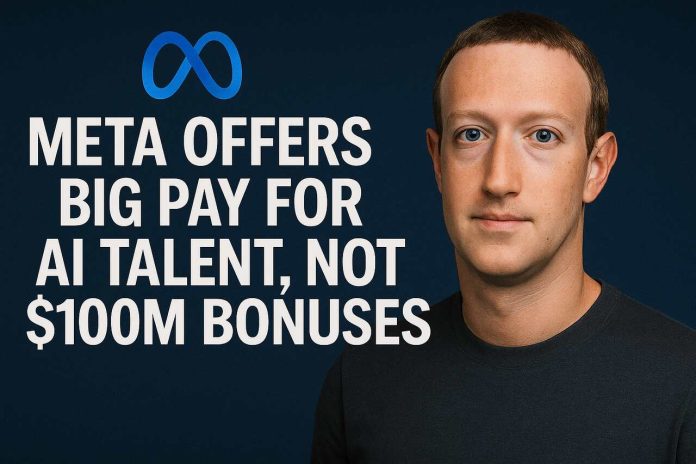Why is Meta offering such high compensation to AI researchers?
Meta is investing aggressively in advanced AI capabilities, particularly through its newly launched superintelligence lab. In order to compete with rivals like OpenAI, Google DeepMind, and Anthropic, the company has begun offering multimillion-dollar compensation packages to top-tier AI researchers. These offers combine high base salaries, performance bonuses, and long-term restricted stock units (RSUs) aimed at incentivizing retention and aligning team goals with corporate success.
Key Components of Meta’s Compensation Strategy:
-
Base Salary and Cash Performance Bonuses
Senior AI researchers at Meta receive substantial base salaries often exceeding $400,000 annually. On top of that, cash bonuses are awarded for achieving internal benchmarks tied to AI performance, innovation milestones, and deployment scale. -
Long-Term Stock Incentives
The centerpiece of these compensation packages is RSUs, which can amount to tens of millions of dollars over a multi-year vesting schedule. These equity grants reflect both the value of Meta stock and expectations of long-term employee retention. -
Equity-Driven Value Proposition
The highest figures—sometimes approaching $100 million—represent total projected value over 4 to 5 years, contingent on stock performance. They are not paid as cash, nor upfront, but serve to secure loyalty from rare talent. -
Strategic AI Investments
Meta’s compensation surge coincides with broader investments in model scaling, infrastructure, and AGI capabilities. The pay levels are meant to match the significance of the mission: building AI systems that rival or surpass human-level intelligence.
Is Meta actually offering $100 million signing bonuses?
No. Despite claims by OpenAI’s Sam Altman, Meta is not offering $100 million signing bonuses. Meta executives, including CTO Andrew Bosworth, have clarified that such figures are being misrepresented. While some offers total in the high-eight-figure range, they are entirely equity-based and tied to tenure and performance—not immediate cash rewards.
Clarifying the Myth of Nine-Figure Bonuses:
-
Misuse of the Term “Signing Bonus”
The term “signing bonus” implies a large lump sum paid upfront. In Meta’s case, there is no evidence of cash bonuses approaching $100 million. The figures cited include multi-year RSUs, not guaranteed pay. -
Public Denials by Meta Leadership
Andrew Bosworth emphasized that offers include “generous compensation packages,” but not in the form of nine-figure up-front payments. The actual structure is aligned with tech-industry norms, especially for executive-level hires. -
Testimonies from Recent Hires
Lucas Beyer, a top AI researcher formerly at OpenAI who joined Meta, publicly dismissed reports of $100 million signing bonuses as “fake news.” His statement aimed to correct the public narrative and reassure the community about compensation norms. -
Equity Value Depends on Company Performance
Projected values reaching into the tens of millions are entirely dependent on Meta’s stock trajectory. This introduces significant variability, unlike cash-based compensation structures.
What does this mean for the AI talent race?
Meta’s aggressive hiring moves represent a major escalation in the competition to attract elite AI researchers. As companies race to develop general-purpose AI, the cost of human capital has soared. Researchers with deep expertise in language models, reinforcement learning, and infrastructure engineering are now among the most sought-after professionals globally.
Impacts on the Broader Industry:
-
Salary Benchmark Inflation
Offers from Meta are expected to raise salary expectations industry-wide. Smaller startups may struggle to match these figures, leading to consolidation of top talent within Big Tech. -
Migration of Talent from OpenAI and Academia
Researchers previously committed to open science or nonprofit work are being lured by lucrative packages. The shift risks slowing open research progress in favor of closed, proprietary development. -
Strengthening of Meta’s Technical Portfolio
With the influx of high-performing researchers, Meta is positioning itself to be a key player in the next wave of foundational AI models, alongside Google and OpenAI. -
Ethical and Competitive Tensions
Some experts worry that such compensation strategies could widen the gap between AI haves and have-nots, concentrating power among a few firms with the deepest pockets.
How should researchers interpret Meta’s offers?
AI researchers evaluating such offers should consider not just compensation, but also the scope of work, ethical alignment, and research freedom. While the monetary appeal is high, long-term satisfaction may hinge more on project impact and organizational culture.
Guidelines for Evaluating High-Stakes Offers
-
Understand Vesting Schedules
Clarify what portion of the offer is guaranteed vs. what depends on stock vesting. Multimillion-dollar offers often hinge on staying for four or more years. -
Align Career Goals with Mission
Ensure that the lab’s goals—whether advancing open models or pursuing AGI—match personal aspirations and values. -
Examine Research Freedom and Publication Rights
Ask whether researchers can publish openly, collaborate with academics, or must operate under strict NDAs and proprietary silos. -
Balance Financial and Intellectual Incentives
A high-paying role may limit exploration, while a slightly lower offer at an open lab may offer more autonomy. Consider long-term impact alongside income.
Conclusion
Meta is offering some of the highest compensation packages in AI today—but the notion of $100 million cash bonuses is unfounded. As the AI arms race intensifies, researchers face unprecedented financial incentives, along with equally significant ethical and strategic choices.
